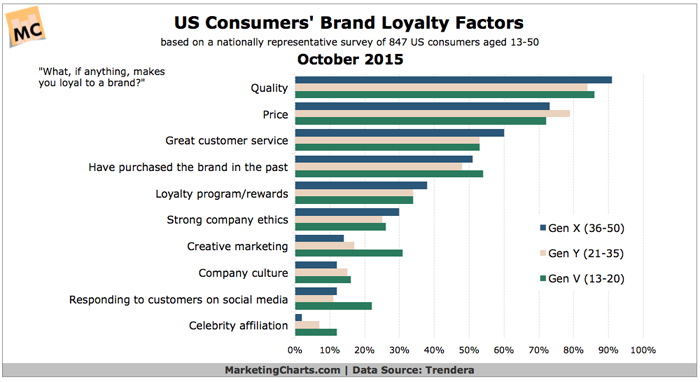What makes customers buy and what makes them brand-loyal might not be all that far apart. A new Trendera study reveals the top 10 brand loyalty factors with US consumers ranging in age from 13-50.
Top 10 Brand Loyalty Factors with U.S. Consumers
Quality and price top the list of factors that U.S. consumers say makes them loyal to a brand, according to research by Trendera. At the risk of pointing out the obvious, it’s still interesting to note that these are generally the reasons people buy in the first place – but this isn’t the only takeaway for brand marketers.
Loyalty programs barely make the top five list of reasons people say they become loyal to brands, despite the money and resources that have been poured into loyalty programs over the past decade, indicating that there is room for improvement. A business that successfully manages to re-think their loyalty program and makes it truly meaningful to buyers could create a serious competitive advantage for itself.
The biggest generational divides are the importance of creative marketing and whether and how brands respond to customers on social media when it comes to the youngest U.S. consumers surveyed, known as Generation V aged 13-20. In fact, creative marketing was even more important to Gen V than strong brand ethics and responding to customers on social media was almost as important.
Celebrity affiliation was nearly as influential with Gen V as company culture; although to be fair, this generation has not had first-hand experience with the complexities of company culture as of yet! As these younger consumers begin to gain more purchasing power and ultimately enter the workforce themselves, it will be important for brand marketers to discover whether these factors continue to weigh more heavily with this generation.
Top 10 Brand Loyalty Factors with Generation X from Most to Least Important
- Quality
- Price
- Great customer service
- Past interactions
- Loyalty program or rewards
- Strong ethics
- Creative marketing
- Company culture; tied with,
- Responding to customers on social networks
- Celebrity affiliation
Top 10 Brand Loyalty Factors with Generation Y from Most to Least Important
- Quality
- Price
- Great customer service
- Past interactions
- Loyalty program or rewards
- Strong ethics
- Creative marketing
- Company culture
- Responding to customers on social networks
- Celebrity affiliation
Top 10 Brand Loyalty Factors with Generation V from Most to Least Important
- Quality
- Price
- Past interactions
- Great customer service
- Loyalty program or rewards
- Creative marketing
- Strong ethics
- Responding to customers on social networks
- Company culture
- Celebrity affiliation

The Best Place to Compete for Brand Loyalty
Given that quality is not a concern and that pricing is competitive, while consumers say these factors top the list of brand loyalty drivers, they aren’t where a business can create competitive advantages and increase brand loyalty with all three generations of U.S. consumers. Customer service and past interactions come in at number 3 and 4 on these lists with all consumers which leads us to believe that customer experience is the best place to compete for brand loyalty.
A remarkable customer experience becomes the “past purchasing interactions” that consumers point to as the reasons they return to a business and feel loyalty to its brand. Customer service that stands out from the service they can receive in other businesses is what makes it great.
The way consumers feel about doing business with a brand outweighs the monetary and other tangible rewards that a brand offers in return for loyalty. Customer experiences become the stories that patrons repeat to friends, loved ones and colleagues. They are the driving force behind social media shout outs and recommendations. They are the reasons that followers open a brand’s emails and follow them online.
Instead of thinking about the customer experience at your business as a whole, and using words that describe your brand experience and values in general terms, try breaking it down into customer experience touch points, instead. Every customer touch point contributes to their experience, and so each represents an opportunity for you to generate the positive emotions that make them feel satisfied, happy, and proud of doing business with you, time and again.

